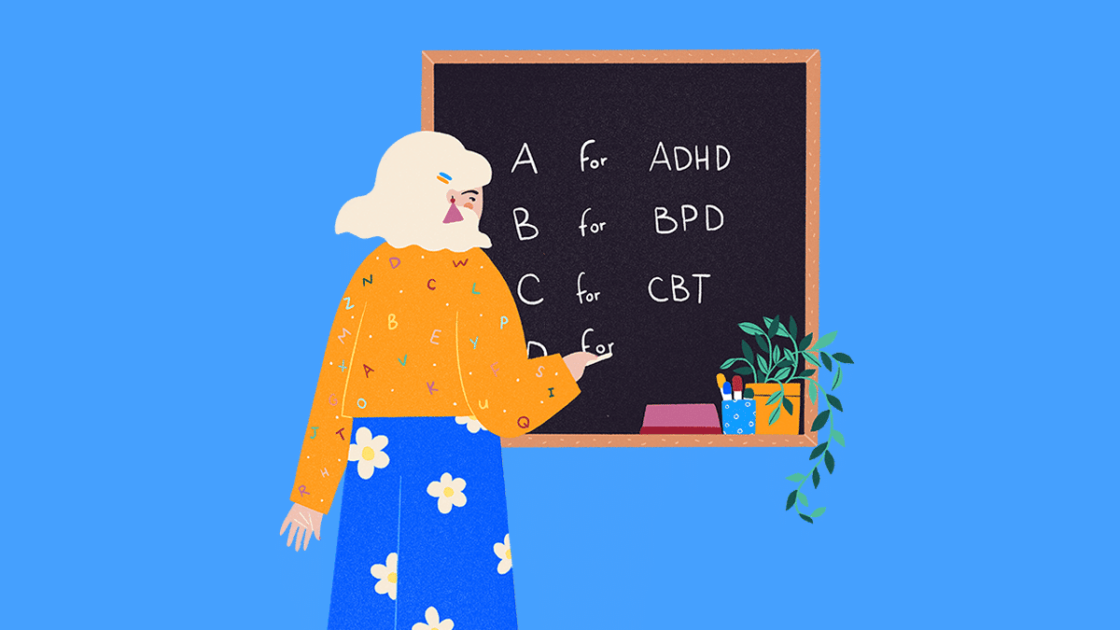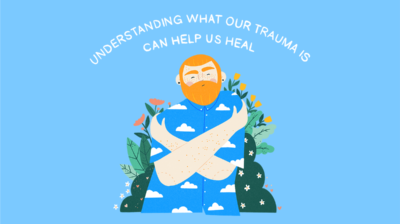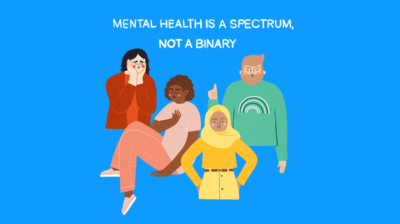An introduction to mental health terminology
Learn the basics about a few common mental health conditions and types of talk therapy.

Everyone has a unique and personal experience of mental health. In general, mental health can be thought of as a spectrum, ranging from excellent mental wellbeing at one end, to severe debilitating symptoms at the other end. Individual people have their own unique mental health spectrums. Given that mental health is a broad field with many different terms, you might sometimes find it challenging to keep up with and understand mental health terminology.
Mental health describes:
- Your thoughts, feelings, and emotions
- Your ability to solve problems and achieve goals
- Your ability to connect to other people
- Your capacity to understand the world around you
On the other hand, mental illness refers to a collection of conditions that can negatively impact mental health. Mental health professionals, like psychiatrists and psychologists, typically diagnose mental health conditions. There are a variety of treatments and recovery options available that can help people better manage their symptoms, maintain daily wellness and improve their quality of life. People from all backgrounds can experience mental illness. However, some groups are more at risk of experiencing mental illness due to social inequalities.
Mental health terminology
This article provides simple definitions of a few mental health conditions and outlines some common talk therapies that can help individuals facing mental health challenges and support their overall well-being. While this is a great place to start gaining a more in-depth understanding of mental health, you can learn more about these topics by talking to your GP or a mental health professional.
Mental health conditions
ADHD
ADHD stands for attention deficit hyperactivity disorder. Symptoms of ADHD in childhood can include hyperactivity, difficulties with impulse control, and trouble maintaining attention and focus. In adulthood, ADHD can affect organisational skills and concentration in work or education. ADHD can also impact relationships and self-esteem. ADHD can be managed in a variety of different ways, including talk therapies, medication, and a combination of both.
Bipolar Disorder
Bipolar Disorder is a mental health condition that causes extreme changes in mood. The condition is often broken down into different types depending on how a person experiences these mood changes and the impact they have on their daily functioning. Some people with bipolar disorder go through periods of feeling very low (depression), where they may feel hopeless or have low self-esteem, and periods of feeling very high (mania), where they may have lots of energy, racing thoughts, and trouble sleeping. Some people with bipolar describe mania as “feeling high.” During manic episodes, some people may experience psychosis symptoms, but not everyone does.
While many people with bipolar disorder experience alternating episodes of depression and mania, some only have manic episodes. Others may experience hypomania, a less severe form of mania that usually doesn’t cause psychosis symptoms and tends to last for a shorter time.
Borderline Personality Disorder (BPD)
Borderline personality disorder (BPD), also known as Emotionally Unstable Personality Disorder (EUPD), is a mental health condition affecting a person’s mood, how they view themselves, and how they interact with others. Mental health professionals diagnose BPD when a person shows a certain number of recognisable symptoms, including:
- a persistently unstable sense of self or self-image
- impulsive behaviours
- chronic feelings of emptiness
- intense anger that is hard to control or out of proportion to the situation
- intense or unstable patterns of relationships
- strong efforts to avoid feelings of abandonment
The symptoms of EUPD often start in adolescence and continue into adulthood. However, people with BPD can see improvements in their symptoms and quality of life through psychotherapy, such as dialectical behaviour therapy (DBT).
The precise causes of EUPD remain unclear. However, evidence suggests that a combination of genetic factors and childhood trauma may play an important role in the development of BPD.
Body Dysmorphia Disorder (BDD)
Body dysmorphic disorder (BDD), or body dysmorphia, is a mental health condition where a person spends a lot of time each day worrying about ‘flaws’ in their appearance. These perceived flaws are often unnoticeable to others. People with BDD may repeatedly inspect their ‘flaws’ or take many steps to try and hide them or cover them up. Having BDD does not mean you’re vain or self-obsessed. People of any age can have BDD, but it’s most common in young people and affects all genders.
Depression
Depression is a mental health condition that causes feelings of low mood that interfere with a person’s daily functioning. These feelings of low mood usually last for an extended period of time. However, some people also experience shorter episodes of low mood in response to stressful or traumatic life experiences. Depression affects one in 10 people in Ireland but is often treatable. Symptoms of depression often include feelings of overwhelming sadness and hopelessness, and loss of interest in activities that were previously enjoyed. Depression can also cause sleep disturbances, changes in appetite, and thoughts of death, suicide or self-harm.
Dissociative Disorders
Dissociative disorders are a type of mental health condition in which a person feels detached from their surroundings, feelings, memories, or emotions. Feelings of being disconnected from yourself and/or the world around you can cause significant physical and psychological challenges. Many people with a dissociative disorder have survived a traumatic event. Some people are aware of their dissociative symptoms, while others may not realise they have them. Symptoms of dissociation can also include episodes of amnesia or memory loss, where a person might forget people, events, or what they were doing.
Eating Disorders
Three commonly known eating disorders include anorexia nervosa, bulimia nervosa and binge eating disorder. A person can also have a mixed type of eating disorder with a combination of symptoms. Eating disorders can affect your thoughts, feelings, and behaviours. A person with an eating disorder may use food and weight as a way to cope with emotional distress. Some people with eating disorders judge their self-worth based on their physical shape and weight. All age groups, gender, socio-economic and cultural backgrounds can be impacted by eating disorders. Read more about the different types of eating disorders.
General Anxiety Disorder (GAD)
Anxiety is a feeling of unease or worry that often revolves around anticipation of an uncertain future event. It is normal for everyone to experience anxiety from time to time. With Generalised Anxiety Disorder (GAD) however, people find it hard to control their anxiety, which has a significant negative impact on their everyday life. GAD can cause both mental and physical symptoms. People with GAD may feel anxious most days. These symptoms vary from person to person but can include having trouble concentrating and being unable to sleep.
Mood Disorders
Mood disorders are a collection of mental health conditions that affect a person’s mood or emotional state. Often, someone’s mood changes depending on the situation they’re in. But people who live with mood disorders can experience long periods of intense sadness, anger or other emotional states. These emotional states are often disproportionate (mismatched) to the situation or circumstances a person is experiencing. Major depressive disorder and bipolar disorder are two of the most common mood disorders.
Obsessive-Compulsive Disorder (OCD)
Obsessive-Compulsive Disorder (OCD) is a mental health condition where a person experiences unwanted, intrusive thoughts, images or urges. People living with OCD compulsively repeat certain action (such as turning on and off a light switch) in order to manage the anxiety generated by intrusive thoughts or images. For example, a person may have unwanted intrusive thoughts that something bad will happen to them or their family. To cope with these thoughts, they might feel compelled to repeat certain actions or rituals, such as cleaning or checking that the doors are locked. Carrying out a routine or action can give a person with OCD temporary relief from their anxiety because it can support them to feel in control of a situation and its outcome.
Panic Disorder
Panic disorder is an anxiety disorder where a person may regularly have sudden attacks of panic or fear. Everyone experiences feelings of anxiety and panic at certain times. This is a natural response to stressful or dangerous and/or uncertain situations. But someone with panic disorder frequently feels anxiety and stress and experiences regular panic attacks, often for no apparent reason.
Postnatal Depression (PND)
Postnatal Depression (PND) is a type of depression some people experience after they have given birth. It usually develops in the first four to six weeks after childbirth, although in some cases it may not develop for several months. Symptoms of postnatal depression include low mood, feeling unable to cope, and difficulty sleeping.
Post-Traumatic Stress Disorder (PTSD)
PTSD is a mental health condition that is triggered by a traumatic event. A person suffering from PTSD can experience symptoms such as flashbacks of the event, nightmares, severe anxiety, and uncontrollable thoughts about the event. They may also avoid places or activities associated with the event and experience negative changes in their thoughts, feelings and reactions. It is common for a person who has experienced trauma to have some difficulty with coping or adjusting. However, if these difficulties do not get better with time and self-care, they may develop PTSD. The symptoms of PTSD can begin to show a month after a traumatic event but may not appear for years.
Schizophrenia
Schizophrenia is a mental health condition which affects the way a person thinks, feels and behaves. The condition usually starts in a person’s late teens or early 20s, and is found to affect about one in 300 people worldwide. A person living with schizophrenia is experiencing or has experienced symptoms of psychosis. Psychosis is a collection of symptoms common to a variety of mental health conditions, including schizophrenia and bipolar disorder. These symptoms typically interfere with a person’s daily lives. Fortunately, there are effective treatments for psychosis, and recovery is possible with the right support.
Some people may only have one episode of psychosis in their lifetime. Other people may experience multiple episodes of psychosis. Regardless of how many episodes a person has experienced, it is possible to manage symptoms with a combination of talk therapy, medication, and other support.
When a person living with schizophrenia experiences an episode of psychosis, they have experiences that are real for them but not for others around them. A person living with schizophrenia may experience hallucinations, where they see, hear or experience things that others do not. They may also experience delusions or unusual, often exaggerated, beliefs that others without psychosis symptoms may find difficult to understand. Symptoms may also include disorganised speech and trouble with thinking, as well as reduced motivation, reduced display of emotion, and social withdrawal.
Social Anxiety Disorder
Social Anxiety Disorder, also called social phobia, is an anxiety disorder in which a person has an excessive fear of social situations. Many people feel shy or anxious in certain social environments. For someone with social anxiety disorder, being around others can be challenging, making it hard to function in important areas of life like work or school.
Seasonal affective disorder (SAD) or ‘seasonal depression’
Seasonal affective disorder (SAD), sometimes called seasonal depression, is a type of depression that comes and goes in a seasonal pattern. SAD is sometimes known as “winter depression” because the symptoms tend to be more obvious and severe during the winter. Other people with SAD may have symptoms during the summer and feel better during the winter. The exact cause of SAD remains unknown. However, it is likely that environmental factors, such as lower levels of sunlight during the winter months, play an important role. They may do this by influencing the levels of chemicals in your body, like serotonin and melatonin.
Talk therapies
Talk therapies involve talking to a trained mental health professional about your thoughts, feelings and behaviours. There are many different types of talking therapy, but they all aim to:
- Give a person a safe environment to talk about what they’re experiencing
- Support a person to make sense of their difficulties and understand themselves better
- Assist a person in working through and living with difficult or complex emotional states
Counselling
Counselling is a type of talk therapy or psychological therapy. It involves speaking to a counsellor about how you’re feeling. Counsellors are trained to listen and can support a person to address negative thoughts, feelings, and behaviours. They are also skilled at helping clients express their worries and concerns. Through counselling, a person can explore both their concerns and positive ways of managing them in a safe environment.
Finding a counsellor is not a one-size-fits-all process. What’s most important is finding a counsellor with whom you can connect and whose approach and style resonate with you. To learn more about the qualifications to look for in a counsellor and how to access counselling, check out our article on private counselling and psychotherapy.
Psychotherapy
Psychotherapy refers to the use of talk therapy to treat mental health issues and mental distress. It can be offered to individuals, couples, and families. Psychotherapy can also range from short-term to long-term depending on the needs of the person or group seeking the therapy.
During psychotherapy, a trained psychotherapist helps the client tackle different problems they are facing. Psychotherapists should help create a safe space where you can explore situations or relationships that are contributing to feelings of emotional distress. Psychotherapists practise active listening and can support you to develop greater levels of self-awareness. Different psychotherapists are trained in various therapeutic approaches, including Cognitive Behavioural Therapy (CBT), humanistic and integrative therapy, couple and family therapy, among others. Read more about the different types of therapy.
Cognitive behavioural therapy (CBT)
Cognitive Behavioural Therapy (CBT) is a type of psychotherapy used to treat various mental health challenges, including anxiety disorders and depression. Research indicates that CBT can effectively relieve symptoms and improve well-being for many people facing these difficulties. CBT operates on the principle that our thoughts influence our behaviours and feelings. By changing unhelpful thought patterns, individuals can reframe their perspectives on difficult life situations. The Irish Association for Behavioural and Cognitive Psychotherapies accredits CBT practitioners who maintain high professional and ethical standards.
Dialectical Behaviour Therapy (DBT)
Dialectical Behavioural Therapy (DBT) is a type of psychotherapy used to help people manage challenging emotions. DBT focuses on four main concepts:
- Being fully aware in the moment (mindfulness)
- How to effectively manage conflict with others (interpersonal problem-solving)
- How to tolerate difficult situations (distress tolerance)
- How to manage, tolerate, and respond to difficult emotions (emotional regulation)
DBT has also been effective in treating substance abuse disorders, depression, eating disorders, post-traumatic stress disorder (PTSD), and borderline personality disorder (BPD), amongst other conditions.
Feeling overwhelmed and want to talk to someone?
- Get anonymous support 24/7 with our text message support service
- Connect with a trained volunteer who will listen to you, and help you to move forward feeling better
- Whatsapp us now or free-text SPUNOUT to 50808 to begin.
- Find out more about our text message support service
If you are a customer of the 48 or An Post network or cannot get through using the ‘50808’ short code please text HELLO to 086 1800 280 (standard message rates may apply). Some smaller networks do not support short codes like ‘50808’.






